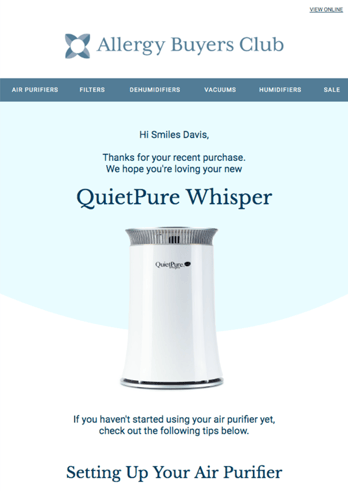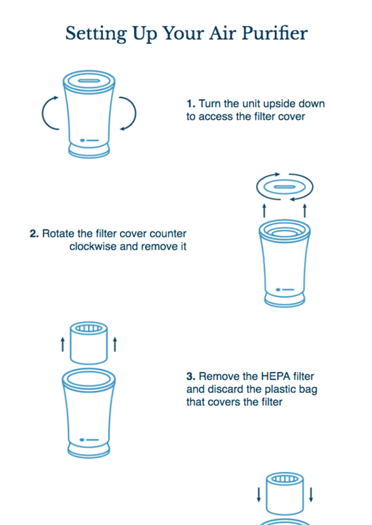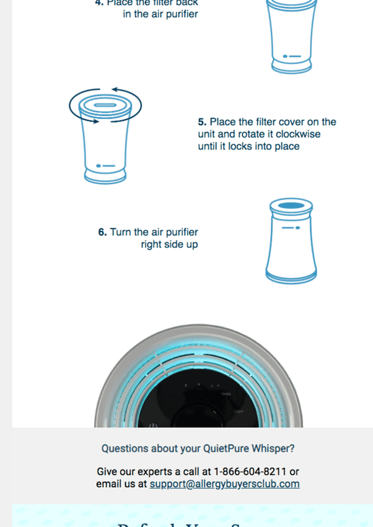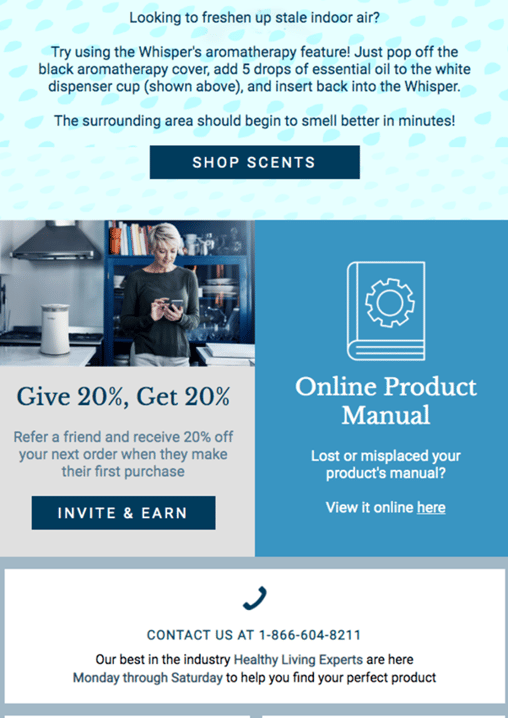HEY! Over here! Look, look at me! Yes, me, the one with the flailing arms, yelling. Did I catch your eye? Wait, you were distracted by a fantastically structured welcome email instead. Oh, no, that's fine.

I mean, considering sending a welcome email will likely net you 320% more revenue than promotional emails, I get it. Still stings a bit, though.
Plus, you might even see a 86% lift in unique open rate, on top of a 196% improvement in unique click rate. So, it seems like people go mad for welcome emails. And who can blame them?
But why, oh why, are welcome emails so effective? Well, first up:
Customers Expect Welcome Emails
One of the reasons why it's so important to have welcome emails is because people expect welcome emails. I mean, 74.4% of respondents even reported that they anticipate one. So, why leave your customer's waiting?
So, if an email never arrives, they might notice or, worse, they might just forget about you entirely. But if this happens, the start of a conversation is cut down, leaving your client confused and disheartened.
Not only does this damage the client's relationship with your brand, but now there's no way for them to follow through on their intentions. And you're missing out on the benefits of the next benefit, which is:
Welcome Emails Have a High Open Rate
Open rates for welcome emails are, on average, 50%. Compared to standard newsletters, that's 86% more effective.
So, there's an opportunity to reach your audience in numbers you'll probably not see again.
When a customer has gone to the effort of signing up, making a purchase, enquiring about a service, they are showing a ready willingness to engage with your brand. They have literally gone out their way to be your mate, and you're snubbing them 😞. They want to know more about your company, and might be close to making a purchase.
These customers are hot, hot leads. So, use your email to describe the goals of your business, and a way for your customers to interact further. Remember, subscribers who receive a welcome email show 33% more engagement with the brand.
So, I'm going to combine the next benefit, with an example of a company bossing it. I know, I do spoil you.
Welcome Emails Continue the Relations: Post-Purchase Emails and 'Allergy Buyers Club'
It is 10x more expensive to get a new customer, than to convince and sell to an existing customer. Plus, existing customers are nine times more likely to convert, and also spend 500% more than new customers. This is because a trust has already been formed.
On top of this, transactional emails are opened at twice the rate of promotional emails.
Despite all of this, some marketers give little thought to their post-purchase email sequences, only sending a proof of purchase, and that's it. But these emails are prime real estate for improving customer experience.
This might involve a clear tracking system, a way to contact customer service, an introduction to your brand or, in the case of Allergy Buyers Club', a tutorial on how to use their product.
So, they're not just confirming someone's purchase, but are making sure they are enjoying and using the product.
Plus, they've also included any customer service help the client might need on top of this, with links to email support, and a phone number. They've also included this bunch of CTA's and links:
They're utilising that repeat customer stat here. From flogging products that are relevant to their customers previous purchase, to offering money off to word-of-mouth recommendations, these guys are firing on all cylinders.
Welcome Emails Set up Tone: Signing up For a Service and 'Headspace'
Welcome emails are a great way to set up tone. It's a good way to connect with leads, and find out where they are in the customer journey.
When sending an email to a customer, who has either signed up for a freemium or premium service, it's important to decide what the key messages are for these new subscribers. What do your new subscribers need to know about your brand, and what will convince them to convert?
This might mean including info on:
- How the product or service works
- How you're different from their competitors
- How other customers have responded, with testimonials
- How to access a special offer
One company doing this is Headspace. Headspace, a guided meditation app, has a very distinct style and tone.
The lead magnet for the brand is their 10-days of guided meditation, and clients receive this email when they sign up:
This email is a solid example of supporting your brand's message, while staying clean and clear. It has a clear goal, and call to action - getting customers to begin using the app.
Plus, it clarifies that the user has 10 days free to use, and will then need to subscribe to get more. It's a step-by-step guide to the service and brand.
Welcome Emails Build Anticipation and Personalisation: Welcoming Subscribers and 'The Essential Man'
When welcoming new subscribers, there's a few steps you can take to make them feel right at home. This might include:
- Requesting an opt-in confirmation. It might sound a bit counter-intuitive, but offering customers a way out of annoying emails helps to establish trust, and weeds out any potentially inactive or uninterested people from your email list.
- Share links to your social sites. This can encourage further engagement outside of your email, familiarising your client with your brand. It is a good way to begin to integrate your email and social marketing, too.
- Send a coupon or discount code. If you offer a brand or service, outside of the newsletter itself, this can encourage people to open the email, and get reading. Gussy, an online shop, sends clients a welcome email offering 15% off any online purchase, and they are seeing great results from this including a 79% open rate and 21% click-through rate.
One newsletter doing welcome emails right is 'The Essential Man', by men's style coach Peter Nguyen.
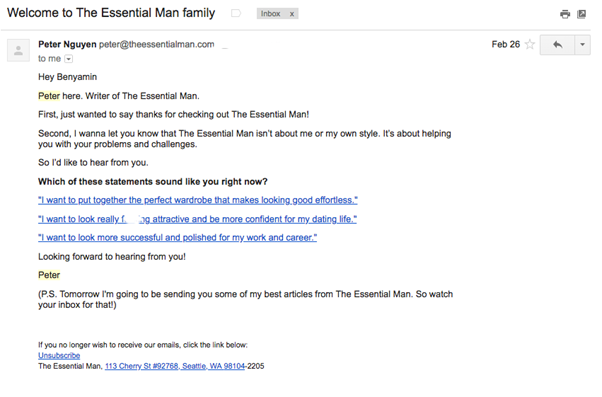
Through this piece, Peter is offering clients a chance to segment themselves, and tailor (heh heh, fashion pun) their experiences to them, in a personalised fashion.
By sending three links, and tagging people based on their clicks, he has the ability to send targeted and immediate follow-up emails.
Peter is using the opportunity to also see which segments his emails attract. With three seperate value propositions, he's showing that he's done his audience research, and has figured out what his different audiences care about.
Plus, this is an example of a plain text email, so an extra little treat for you. Plain text emails always look like they've been sent from a personal account, rather than through an email marketing automation platform, as part of an automated workflow. This makes it seem like Peter is your own personal shopper, messaging you in particular. It's a very clever choice.
A plain text welcome email will help you create a bond with new subscribers, and show them your wish to establish a genuine relationship with them.
Finally, Peter builds anticipation for the next email, stating "Tomorrow I'm going to be sending you some of my best articles...so watch your inbox for that!" This can increase email open rates for your second email.
Welcome Emails Establish your Brand Identity: Not-for-Profit Stories and 'The Franklin D. Roosevelt Park'
Though it's important to establish your brand identity in a welcome email, no matter your industry, non-for-profits tend to do a particularly good job.
With these welcome emails, brands and charities have to decide what the key messages are for new subscribers. And for non-profits, this tends to focus on the story of the company, with inclusions of:
- The charities history and mission
- Stories of the impact the charity has made
- Exclusive perks for donors and members
- A calendar of the year's events, including social media photos.
These kinds of welcome emails are naturally very eye-catching. Plus, since the email account owner won't mark it as spam, the next sales-focused email sent out will be received well and might be opened as well. This means further donations for charities, and more purchases for brands.
The Franklin D. Roosevelt Park does a good job in establishing it's focuses, and potential relationship with the client:
This email has it ALL. From upcoming events, to further reading, the charity is making the most of having access to an interested and currently-engaged client. They also have a little section explaining the history of the park, as well as a map to visit the museum in person.
This encourages the reader to not only stay within the email, but access materials and social sites outside, engage on different channels, and visit the park itself.
It will also be vital, with how detailed this email is, for them to regularly update and tailor the welcome emails. This means including mention of current events and new projects, in order to stay relevant and better connect with readers.

